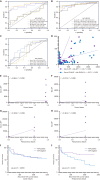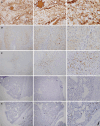Diagnostic value of alpha-fetoprotein and prothrombin induced by vitamin K absence-II in serum, bile, and feces in hepatocellular carcinoma
- PMID: 40487934
- PMCID: PMC12142260
- DOI: 10.4251/wjgo.v17.i5.105311
Diagnostic value of alpha-fetoprotein and prothrombin induced by vitamin K absence-II in serum, bile, and feces in hepatocellular carcinoma
Abstract
Background: Hepatocellular carcinoma (HCC) is the most common pathological type of liver cancer and was the third leading cause of cancer-related deaths worldwide in 2020.
Aim: To evaluate the diagnostic potential of key tumor markers in serum, bile, and fecal samples for detecting HCC.
Methods: Blood, bile, and fecal samples were collected from patients (n = 265) with HCC and cholecystitis from Guangxi Medical University's First Affiliated Hospital. Immunohistochemistry was performed on 69 HCC samples, and 16S ribosomal RNA sequencing was conducted on 166 fecal samples. Tumor marker cut-off values in bile and feces were determined using the Youden index, while serum biomarkers followed hospital standards. Diagnostic performance was evaluated using receiver operating characteristic analysis.
Results: The areas under the curve (AUCs) for distinguishing HCC were 0.898, 0.904, and 0.859 for serum alpha-fetoprotein (AFP), prothrombin induced by vitamin K absence-II (PIVKA-II), and bile AFP, respectively. Serum AFP had the highest diagnostic value (80%) for early-stage HCC. Combination analysis found that bile AFP and serum PIVKA-II achieved the highest AUC of 0.965 (P < 0.001), suggesting that bile AFP may serve as a valuable complementary biomarker, particularly in cases where serum AFP is not significantly elevated. Additionally, bile AFP was positively correlated with Actinomyces, which plays a significant role in promoting tumorigenesis; and was negatively correlated with Faecalibacterium, which was associated with robust anticancer immune responses (P < 0.05). These findings suggest the potential role of gut microbiota in modulating AFP levels and HCC progression.
Conclusion: Bile AFP improved the sensitivity of HCC detection, with the combination of bile AFP and PIVKA-II demonstrating the highest AUC for HCC diagnosis. AFP is associated with poorer clinical outcomes.
Keywords: Alpha-fetoprotein; Bile biomarkers; Diagnosis; Gut-liver axis; Hepatocellular carcinoma; Prothrombin induced by vitamin K absence-II; Receiver operating characteristic analysis; Serum biomarkers.
©The Author(s) 2025. Published by Baishideng Publishing Group Inc. All rights reserved.
Conflict of interest statement
Conflict-of-interest statement: The authors have no conflicts of interest to declare.
Figures




Similar articles
-
Diagnostic value of AFP-L3 and PIVKA-II in hepatocellular carcinoma according to total-AFP.World J Gastroenterol. 2013 Jan 21;19(3):339-46. doi: 10.3748/wjg.v19.i3.339. World J Gastroenterol. 2013. PMID: 23372355 Free PMC article.
-
Diagnostic value of gamma-glutamyltransferase/aspartate aminotransferase ratio, protein induced by vitamin K absence or antagonist II, and alpha-fetoprotein in hepatitis B virus-related hepatocellular carcinoma.World J Gastroenterol. 2019 Sep 28;25(36):5515-5529. doi: 10.3748/wjg.v25.i36.5515. World J Gastroenterol. 2019. PMID: 31576097 Free PMC article.
-
Alpha-fetoprotein, protein induced by vitamin K absence or antagonist-II, lens culinaris agglutinin-reactive fraction of alpha-fetoprotein alone and in combination for early detection of hepatocellular carcinoma from nonalcoholic fatty liver disease: A multicenter analysis.Hepatobiliary Pancreat Dis Int. 2022 Dec;21(6):559-568. doi: 10.1016/j.hbpd.2022.05.003. Epub 2022 May 17. Hepatobiliary Pancreat Dis Int. 2022. PMID: 35643910
-
Protein induced by vitamin K absence or antagonist-II versus alpha-fetoprotein in the diagnosis of hepatocellular carcinoma: A systematic review with meta-analysis.Hepatobiliary Pancreat Dis Int. 2018 Dec;17(6):487-495. doi: 10.1016/j.hbpd.2018.09.009. Epub 2018 Sep 15. Hepatobiliary Pancreat Dis Int. 2018. PMID: 30257796
-
Utility of combining PIVKA-II and AFP in the surveillance and monitoring of hepatocellular carcinoma in the Asia-Pacific region.Clin Mol Hepatol. 2023 Apr;29(2):277-292. doi: 10.3350/cmh.2022.0212. Epub 2023 Jan 30. Clin Mol Hepatol. 2023. PMID: 36710606 Free PMC article. Review.
References
-
- Kim E, Kim D, Lee JS, Yoe J, Park J, Kim CJ, Jeong D, Kim S, Lee Y. Capicua suppresses hepatocellular carcinoma progression by controlling the ETV4-MMP1 axis. Hepatology. 2018;67:2287–2301. - PubMed
-
- Abou-Alfa GK, Meyer T, Cheng AL, El-Khoueiry AB, Rimassa L, Ryoo BY, Cicin I, Merle P, Chen Y, Park JW, Blanc JF, Bolondi L, Klümpen HJ, Chan SL, Zagonel V, Pressiani T, Ryu MH, Venook AP, Hessel C, Borgman-Hagey AE, Schwab G, Kelley RK. Cabozantinib in Patients with Advanced and Progressing Hepatocellular Carcinoma. N Engl J Med. 2018;379:54–63. - PMC - PubMed
-
- European Association For The Study Of The Liver; European Organisation For Research And Treatment Of Cancer. EASL-EORTC clinical practice guidelines: management of hepatocellular carcinoma. J Hepatol. 2012;56:908–943. - PubMed
LinkOut - more resources
Full Text Sources

